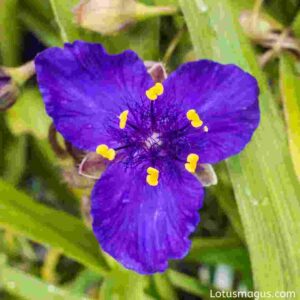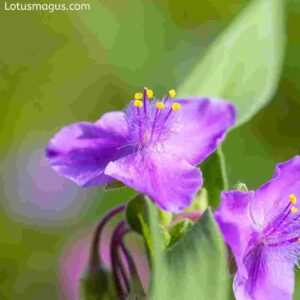In this article I will discuss the purple heart flower, when it blooms, how often and much more. Many people try to find a plant that can do it all, but with the purple heart plant you will be able to fulfill that need in your garden. It is an easy to grow plant that is known to bloom a large number of flowers. In this blog I will show you how to care for the purple heart plants.
What is the purple heart flower?
The purple heart flower also known as Tradescantia pallida comes from the spiderwort family is a perennial year long growing plant They are native to Mexico and other regions. It has dark purple or purplish-black heart-shaped leaves and dense spikes of tiny white flowers in summer. The plant is poisonous to humans and animals, but is a favorite ornamental plant for gardens and container plantings.
How to grow the purple heart flower?
Purple heart flower is one of the easiest plants to grow indoors, but it will also thrive in an outdoor setting. This plant is able to grow in many different types of conditions, including bright sunlight and shade. This plant has long, narrow leaves with a glossy dark green upper surface and a lighter green lower surface. The flowers of this plant are violet and white. The purple heart flower is an evergreen plant.
When does the purple heart flower bloom?

The purple heart flower has a long blooming season, usually lasting from June until October. The flowers are violet, with stamens that are pink or white. It is a perennial plant that can grow to heights of up to three feet. The flowers have three petals, and the leaves have three toothed leaflets. It is a very attractive plant with the blooms on the ends of the stems and the leaves.
What are the best types of soil for the purple heart flower?
The best soil types are a good mix of fine sand, loam, and clay. You can also get good results by using moistened topsoil. If you want to be extra sure to grow a healthy tradescantia, you should opt for a good quality potting soil. The purple-heart flower is originally from Mexico, and it thrives in a variety of conditions. It is an epiphyte and has been in cultivation for centuries. For the best results with your purple-heart flowers, it is best to use rich, well-drained soil. It is a trailing tropical plant that can be found in a variety of soils, but should not be planted in moist soil. The purple-heart flower should be watered often but not when it is raining.
What are the light requirements for the purple heart flower?
Purple heart plants are known to be an air purifying plant. They are most commonly found in humid tropical regions. They love to be in a location with a lot of light, but they can also survive in lower light conditions. They need consistent water and a warm, moist atmosphere. The best type of light for the purple heart plant is sunlight, but indirect sunlight is best.
What are the watering requirements for the purple heart flower?
Purple heart flowers need to be watered from time to time. They are also low-maintenance plants, as they are also recommended for carnivorous plant enthusiasts. This plant is most commonly used as a potted plant indoors, and is a good plant to have in bathrooms and on balconies. This plant is also good for those who have a hard time keeping their plants alive.
What is the best fertilizer for the purple heart flower?
The purple heart flower requires general purpose fertilizer for their bright color and healthy leaf growth. Many people also recommend balanced fertilizer for their overall growth, not just flowers and leaves. You can use any of the fertilizer by diluting it and make sure to read instructions and apply according to it. This way you can avoid any problem that happens due to overuse of fertilizer.
How to care for the purple heart flower?
The purple heart flower or Tradescantia pallida is a trailing tropical plant from the spiderwort family, and native to Mexico. It is a perennial that is primarily grown as a houseplant. This flower is not only beautiful, but very easy to care for. If you have a purple heart flower you can care for it by making sure that it has a bright enough light, proper soil, and a good drink of water. Make sure that you give your purple heart flower the right amount of light. This flower will thrive in both indirect and direct light. The best way to care for this plant is to keep it in an area that is constantly moist rather than in a soil that is constantly wet. The purple heart flower likes moist soil, but the soil should not be too wet.
How can you use the purple heart plant in your home or garden?
The purple heart plant is a trailing plant that can be used in both your home and garden. It is a low maintenance plant that will add a nice splash of color to your room or outdoor space. The purple heart plant is also a great plant for attracting butterflies and other pollinators. It can be used for many things, and is a great plant to grow in your garden. The plant is native to Mexico, and can be found in desert areas. The plant can be used to help reflect heat when it is hot outside, as well as provide a natural ground cover.
Purple heart flower arrangement
The purple heart flower is a type of plant that is often used in flower arrangements. There are many reasons why this type of flower is used, but one of the biggest reasons is that it is a trailing plant. We are often told to use trailing plants in flower arrangements because this allows them to be more free-flowing and in motion. This flower is often used in wedding flowers and arrangements. There are also many occasions where this flower is used.

What does a purple heart flower look like
The flowers are purple in color and have a heart shape with five lobes. This plant is a succulent-stemmed herbaceous perennial that grows to be around two feet tall and blooms from late spring to late summer. The leaves are arranged in rosettes and are generally light green, or in some cases, grayish-green. The flowers are usually about two inches long, and there are usually five petals that make up the heart shape.
Purple heart flower perennial
The purple heart flower is a perennial plant that is native to Mexico, and is in the family of spiderworts. They are usually called the purple heart flower, or the Tradescantia pallida. They are sometimes referred to as the garden spiderwort. The purple heart flower has a thick, succulent, dark green stem that is often used as a houseplant. They are a trailing plant, with a long growth habit and a prolific flowering period. It is also a vining plant that can grow up to a meter long. It is a popular plant because it is easy to grow, and it can handle different lighting conditions. It is a popular plant because it is easy to grow, and it can handle different light conditions. It is a prized plant because of its easy upkeep and its low maintenance. It is also a popular plant because it can be used as a ground cover. It can also be used as a hanging flower decoration, or in a planter.
Red purple heart flower
The flower has a flower head of red-purple and some blue or yellowish-green leaves that are about 30cm (12 inches) long and 8cm (3 inches) wide. It is a plant in the genus Tradescantia which contains many similar species.
Purple heart wandering jew flower
The purple heart wandering jew is a trailing plant with many long, narrow leaves that looks a bit like a spiderwort. This flower has a light purple center and a deep purple edge that covers the petals. Although the center is light, it is what grows around the center that makes the flower really beautiful. The plant prefers full sun and is native to Mexico.
Purple heart flower safe
The purple heart flower(Tradescantia pallida) is an easy to grow and low maintainabale plant. But it is not safe for pets and humans. Particularly the variety known as Tradescantia pallida ‘Purpurea’ is toxic to both cat, dog and humans. And symtoms are releated to stomauch pain and dermatitis.
Final thoughts
We hope you will enjoy our blog post on the purple heart flower! This is a beautiful plant with a variety of uses, from framing a window to a hanging basket. All in all, we hope you will take the time to learn about Tradescantia pallida in our blog and that you will share it with anyone who you think might be interested in it.
